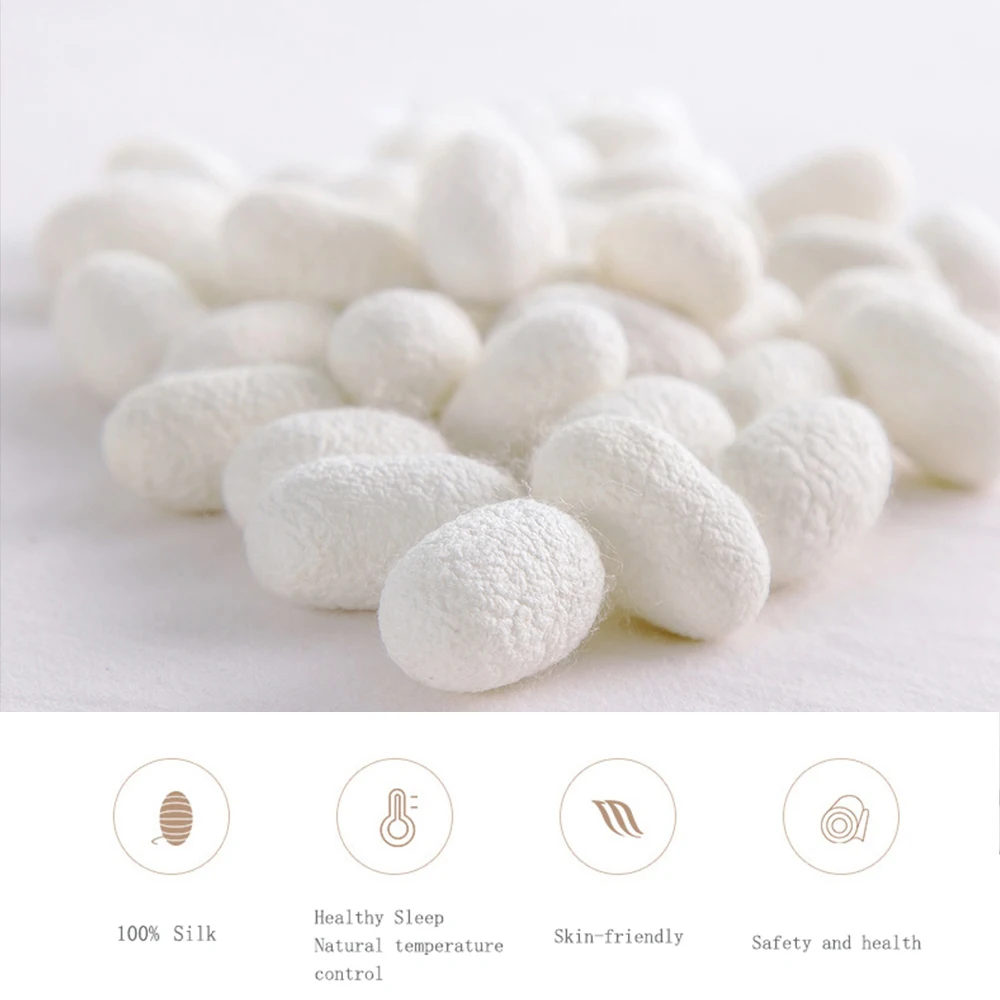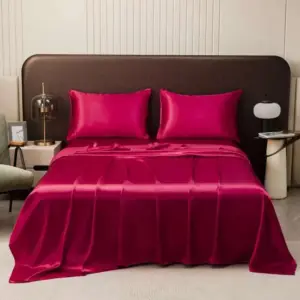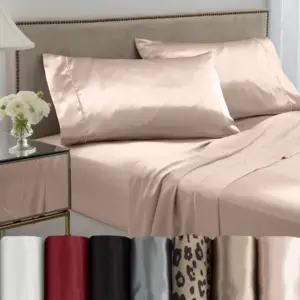Understanding the Art of Layered Bedding
Creating a beautifully layered bed is both an art and a science that transforms your sleeping space into a luxurious retreat. Layered bedding combines different textiles—sheets, duvets, quilts, and decorative elements—to create a bed that’s not only visually appealing but also adaptable to your comfort needs throughout changing seasons.
The strategic combination of quilts and duvets offers remarkable versatility. Duvets provide warmth and loft, while quilts add texture, color, and an additional temperature control option. Together, they create a bed that can be adjusted for personal preference and seasonal changes.
The amazing benefits of Mulberry silk sheets can serve as an excellent foundation for your layered bedding arrangement, providing breathability and comfort that complement additional layers. When mastered, proper bedding layering transforms an ordinary bedroom into a sanctuary that rivals luxury hotels and designer showcases.
In this comprehensive guide, you’ll learn everything from essential foundation layers to expert styling techniques that will elevate your bedding game. Understanding the complete guide to Mulberry silk bed sheets provides valuable context for selecting quality materials as you build your perfect sleep sanctuary.
Essential Bed Layering Foundations
Before adding decorative elements, establishing proper foundation layers ensures both comfort and longevity for your bedding.
Mattress Protection
Start with a quality mattress protector—preferably one that’s waterproof yet breathable. This invisible but crucial layer safeguards your mattress investment while providing a smooth base for subsequent layers. Look for options that offer allergen protection without creating noise or trapping heat.
Fitted Sheets: The First Visible Layer
A well-fitted sheet creates the initial aesthetic and comfort impression. When selecting fitted sheets, consider these factors:
- Depth: Ensure your fitted sheet has adequate pocket depth for your mattress height
- Material: Choose based on personal preference for temperature regulation and texture
- Secure fit: Proper corner elastics prevent annoying nighttime shifting
Premium silk fitted sheets provide exceptional comfort while creating an excellent foundation for additional layers. When applying, start with opposite corners to ensure even tension and a wrinkle-free appearance.
The Flat Sheet Debate
While some view flat sheets as optional, they offer both practical and aesthetic benefits:
- Creates a buffer layer between your body and thicker bedding elements
- Makes cleaning your duvet cover less frequent
- Enables the classic “hotel fold” for a polished appearance
For a true hotel-style presentation, master the hospital corner fold: tuck the bottom edge of the flat sheet under the mattress, then fold the hanging side at a 45-degree angle before tucking the remaining portion.
Understanding Duvets: Your Primary Warmth Layer
Duvets serve as the primary insulation layer in most layered bedding arrangements, providing customizable warmth with relatively little weight.
Duvet Insert Basics
A duvet insert is essentially a soft, flat bag filled with insulating material. The quality and type of fill significantly impact warmth, weight, and durability:
| Fill Type | Warmth Level | Weight | Maintenance | Best For |
|---|---|---|---|---|
| Down | Excellent | Light | Dry clean recommended | Luxury feel, maximum warmth |
| Down Alternative | Very Good | Medium | Machine washable | Allergies, budget-conscious |
| Wool | Excellent | Medium-Heavy | Spot clean only | Natural temperature regulation |
| Silk | Good | Very Light | Dry clean only | Hot sleepers, luxury feel |
Understanding Tog Ratings
Tog ratings measure a duvet’s warmth capacity, with higher numbers indicating greater insulation:
– Summer: 2.5-7.5 tog
– Spring/Fall: 7.5-10.5 tog
– Winter: 12-15 tog
Duvet Cover Selection
Your duvet cover adds both style and protection to your insert. Consider these factors:
- Material texture (crisp cotton, silky sateen, soft linen)
- Closure mechanism (buttons, ties, zippers)
- Pattern scale relative to room size
- Seasonal appropriateness
Our luxury silk bedding sets offer exceptional comfort while adding a sophisticated sheen to your layered arrangement. When placing your duvet on the bed, allow approximately 16 inches of overhang on each side and at the foot for the most appealing presentation.
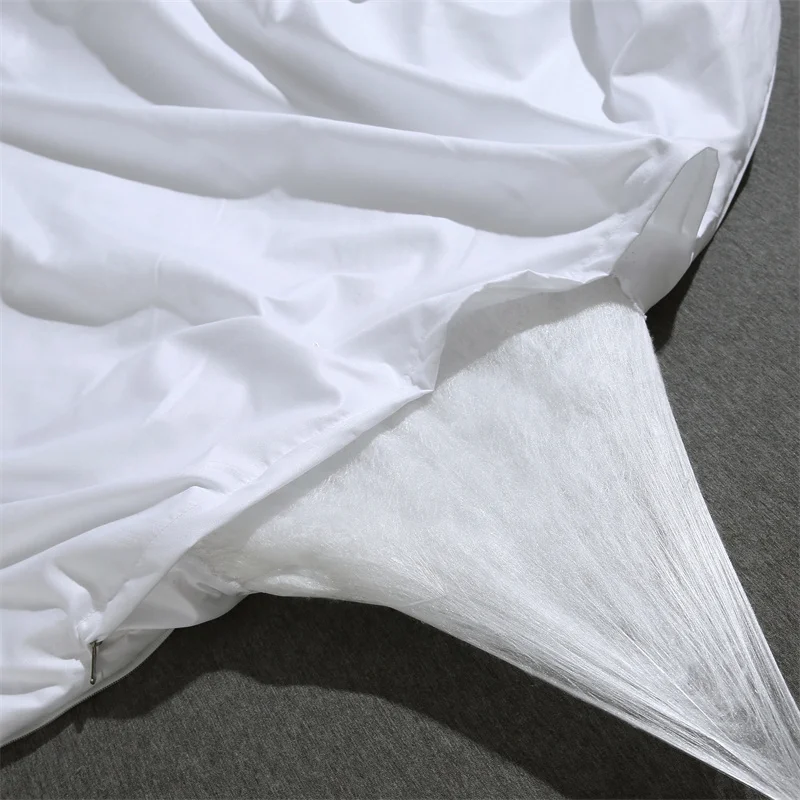
Quilts: Adding Texture, Style and Versatility
While duvets provide warmth, quilts bring texture, color, and additional temperature control options to your bedding ensemble.
Quilt vs. Coverlet: Understanding the Difference
Quilts traditionally consist of three layers—top fabric, batting, and backing—stitched together in decorative patterns. Coverlets are typically lighter, single-layer or thin-fill bedspreads designed primarily for decoration.
Modern quilts range from heirloom-quality hand-stitched creations to machine-produced versions with consistent stitching and contemporary patterns.
Quilt Styles and Their Visual Impact
Different quilt styles create distinct aesthetic impressions:
- Patchwork quilts: Create visual interest and often become focal points
- Whole-cloth quilts: Offer subtle texture through stitching patterns
- Matelassé: Mimic the appearance of quilting but typically feature woven texture rather than actual stitching
- Channel-quilted: Present a modern, streamlined appearance with straight-line stitching
The art of layering silk bedding demonstrates how combining different textures enhances both visual appeal and functionality in your bedroom. When selecting a quilt, consider both the visual weight (how heavy it appears) and physical weight, as these factors influence how it drapes and integrates with other elements.
Three Primary Methods for Layering Quilts with Duvets
Now that you understand the individual components, let’s explore specific techniques for combining quilts and duvets effectively.
Method 1: Quilt as Decorative Top Layer
This popular approach showcases your quilt while maintaining the warmth of your duvet underneath.
Full Display Technique:
1. Start with your foundation layers (fitted sheet, flat sheet)
2. Place the duvet with cover fully on the bed
3. Lay the quilt completely over the duvet
4. Fold the top 12-18 inches of both layers down together
5. Add pillows and accessories
Folded Foot Technique:
1. Make the bed with foundation layers and duvet
2. Fold the quilt in thirds horizontally
3. Place across the lower third of the bed
4. Style pillows against the exposed duvet
This method works beautifully when you want to showcase a decorative quilt while keeping the duvet’s warmth easily accessible. It’s particularly effective for layered silk bedding arrangements that combine functionality with visual appeal.
Method 2: Duvet as Top Layer with Quilt Underneath
This arrangement prioritizes the duvet’s appearance while using the quilt as an additional warmth layer.
Implementation Steps:
1. Place fitted and flat sheets on the bed
2. Lay the quilt fully across the bed
3. Cover with the duvet, folded down approximately 15 inches from the head
4. Arrange pillows against the exposed quilt section
This method offers several advantages:
– Creates a cleaner, more minimalist look when using a solid-color duvet
– Provides excellent temperature control for moderate climates
– Works well for sleepers who prefer easy access to their duvet
Method 3: Quilt Alone as Main Top Layer
During warmer months or in milder climates, this approach simplifies the bed while maintaining visual interest.
Styling Approach:
1. Apply foundation layers as usual
2. Place the quilt as the primary top layer
3. Store the duvet in a closet or chest, or fold it decoratively at the foot
4. Add extra throw blankets for supplemental warmth if needed
This streamlined approach creates a lighter aesthetic perfect for summer while allowing quick adaptation if temperatures drop unexpectedly.
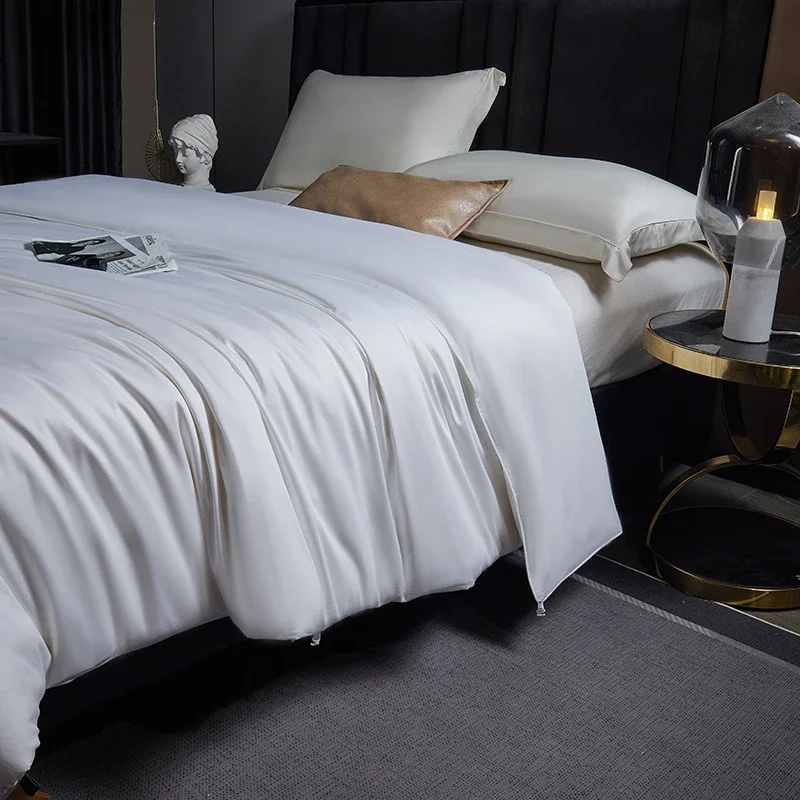
Pillow Layering: Creating Height, Structure and Comfort
A thoughtfully arranged pillow display adds vertical dimension and completes your bedding ensemble.
Functional Sleeping Pillows
Begin with properly sized sleeping pillows based on your bed dimensions:
– Twin: 1 standard pillow
– Full: 2 standard pillows
– Queen: 2 queen pillows
– King: 2 king or 3 standard pillows
Position sleeping pillows at the back of your arrangement, typically against the headboard or wall, and covered with pillowcases matching or coordinating with your sheets.
Euro Shams: The Structural Element
Euro shams are large (typically 26”×26”) square pillows that create height and structure:
– Twin/Full: 1-2 euros
– Queen: 2-3 euros
– King: 3 euros
Place these at the very back of your arrangement, even behind sleeping pillows, to create a backdrop with substantial visual weight.
Decorative Pillows: The Finishing Touch
Complete your arrangement with decorative pillows following this formula for balance:
– Choose odd numbers (3 or 5 total pieces)
– Vary sizes and shapes (square, rectangular, bolster)
– Include at least one pattern if your bedding is solid
Quality silk pillowcases elevate both the comfort and appearance of your pillow arrangement while providing beauty benefits during sleep.
Accessorizing Your Layered Bed: Throws and Final Touches
The final layer of bed styling involves thoughtfully selected accessories that enhance both form and function.
Throw Blanket Selection and Placement
A well-chosen throw blanket adds texture, color, and an additional warmth option. Consider these placement techniques:
- Diagonal Corner Drape: Fold the throw diagonally and place across one corner for casual elegance
- Horizontal Foot Placement: Fold in thirds and place evenly across the foot of the bed for a hotel-like finish
- Cascading Side Drape: Allow the throw to cascade over one side for an inviting, relaxed look
Choose throw dimensions appropriate to your bed size—typically 50”×60” for a queen and 60”×80” for a king. The material should complement but not exactly match your existing bedding.
Bed Skirting Considerations
If your bed frame exposes space beneath the mattress, a bed skirt or box spring cover provides a finished appearance. Options include:
– Tailored skirts with clean lines for contemporary spaces
– Ruffled or pleated versions for traditional bedrooms
– Platform bed wraps for modern bed frames
Understanding how to coordinate bedding colors for a harmonious sanctuary helps ensure these final elements integrate seamlessly with your overall design.
California King Silk Fitted Sheet, King Size Silk Fitted Sheet, Mulberry Silk Fitted Sheet, Queen Size Silk Fitted Sheet
Price range: $120.04 through $390.79 Select options This product has multiple variants. The options may be chosen on the product pageFull-size Silk Sheets, King Size Silk Sheets, Queen Size Silk Sheets, Twin Size Silk Sheets, Washable Silk Sheets
Price range: $95.95 through $178.37 Select options This product has multiple variants. The options may be chosen on the product page100% Silk Sheets, Green Silk Sheets, King Size Silk Bedding Set, Mulberry Silk Bedding Sets, Queen Size Silk Bedding Set
Price range: $1,246.21 through $1,615.22 Select options This product has multiple variants. The options may be chosen on the product pagePink Silk Sheets, Twin Size Silk Sheets
$171.80 Select options This product has multiple variants. The options may be chosen on the product pageFull-size Silk Sheets, Pink Silk Sheets
$136.31 Select options This product has multiple variants. The options may be chosen on the product pageGrey Silk Sheets, Silk Sheet and Pillowcase Set
Price range: $88.20 through $146.64 Select options This product has multiple variants. The options may be chosen on the product page
Expert Styling Tips for a Designer-Worthy Bed
Elevate your layered bed from simply comfortable to visually stunning with these designer techniques.
1. Master the Art of Texture Mixing
Create visual depth by combining three or more distinct textures:
– Smooth (silk, sateen, percale)
– Textured (matelassé, waffle weave, linen)
– Plush (velvet, sherpa, chunky knit)
This textural contrast creates visual interest even within a monochromatic color scheme. The principles of styling silk sheets in the bedroom demonstrate how luxury fabrics can be mixed with contrasting textures for maximum impact.
2. Balance Pattern and Scale
When mixing patterns, follow these guidelines:
– Include at least one solid color to provide visual rest
– Vary pattern scale (large, medium, small)
– Connect patterns through a consistent color thread
– Limit to 2-3 patterns maximum for cohesive look
3. Perfect Your Pillow Chopping Technique
The “pillow chop” creates that desirable center indentation seen in designer beds:
1. Position the pillow
2. Karate-chop the top center with the side of your hand
3. Gently adjust the resulting “V” shape
4. Repeat with consistent pressure across all decorative pillows
4. Maintain Proper Volume and Fluffiness
Preserve the luxurious look of layered bedding by:
– Shaking out duvets daily to redistribute fill
– Using appropriate pillow inserts (slightly oversized for covers)
– Fluffing pillows regularly to maintain their shape
– Laundering items according to manufacturer instructions
5. Adapt Seasonally While Maintaining Style
Transition your layered bed between seasons by:
– Switching duvet weights while keeping the same cover
– Replacing heavy quilts with lightweight coverlets
– Changing throw pillow covers rather than entire pillows
– Substituting chunky winter throws with lighter summer versions
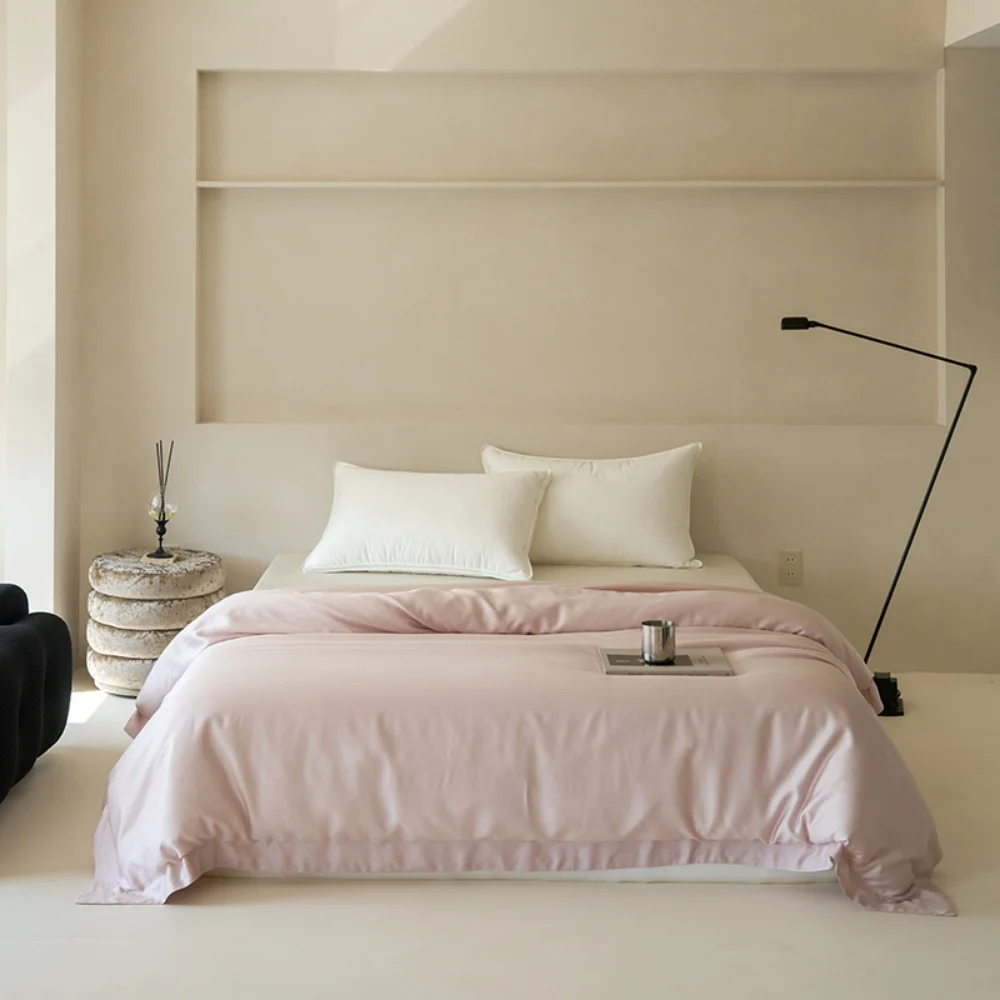
Solving Common Layering Challenges
Even experienced decorators encounter challenges when creating layered beds. Here are solutions to common issues:
Managing Excessive Weight
If multiple layers feel too heavy:
– Select a lower tog-rated duvet
– Consider swapping traditional quilts for lightweight coverlets
– Use percale or silk sheets that feel lighter than flannel or jersey
– Choose silk sheets that provide warmth without weight
Preventing Layer Slippage
Keep your beautifully arranged layers in place by:
– Using sheet suspenders or holders under the mattress
– Selecting duvet covers with corner ties to secure inserts
– Adding non-slip fabric strips between quilt and duvet
– Placing heavier layers underneath lighter ones
Accommodating Different Temperature Preferences
For partners with different warmth needs:
– Consider dual-zone duvets with different tog ratings
– Layer personal throw blankets on each side
– Use a medium-weight shared duvet with individual quilts
– Position the bed so that air vents don’t blow directly on one person
Streamlining Daily Bed-Making
Make daily bed-making with multiple layers less time-consuming:
– Perfect the “sheet tuck and pull” technique
– Consider using a single decorative pillow arrangement daily, saving the full display for special occasions
– Master the “sweep and straighten” method rather than precise alignments
– Focus on smoothing visible layers only
Seasonal Bedding Adjustments: When and How to Adapt Your Layers
Modifying your layered bed throughout the year keeps it both functional and seasonally appropriate.
Summer Layering Strategy
For warmer months:
– Replace heavy duvets with lightweight alternatives or simply use a duvet cover
– Substitute thick quilts with thin coverlets or lightweight cotton blankets
– Use cooling silk bedding for temperature regulation to prevent overheating
– Store winter bedding in breathable cotton bags with cedar blocks
Winter Warmth Approach
When temperatures drop:
– Layer a quilt between your sheets and duvet for added insulation
– Consider flannel sheets as your base layer
– Add faux fur or chunky knit throws for both warmth and texture
– Use the highest appropriate tog rating for your duvet
Transitional Seasons
During spring and fall:
– Keep both lightweight and medium-weight options accessible
– Use the “triple sheet method” (flat sheet above and below the blanket)
– Position quilts folded at the foot of the bed for easy access
– Consider layering two lightweight blankets instead of one heavy one
Frequently Asked Questions About Bedding Layers
Is a flat sheet necessary with a duvet?
While not strictly necessary, a flat sheet creates a barrier that keeps your duvet cover cleaner for longer and provides an additional temperature control option.
How often should each bedding layer be washed?
Sheets and pillowcases: Weekly
Duvet covers: Every 2-4 weeks
Quilts and coverlets: Monthly or as needed
Duvet inserts: 2-3 times yearly or follow manufacturer’s instructions
Can silk bedding be incorporated into layered arrangements?
Absolutely! Understanding why choose Mulberry silk sheets helps appreciate how silk integrates beautifully into layered bedding, adding luxury while providing temperature regulation benefits.
How do you prevent a duvet from shifting inside its cover?
Look for duvet covers with interior corner ties that attach to corresponding loops on your insert. Alternatively, use safety pins at the corners or duvet clips designed specifically for this purpose.
Maintaining Your Layered Bedding: Care and Longevity
Proper care ensures your beautifully layered bed remains fresh and inviting for years.
Washing Frequency Guidelines
Establish a rotating schedule that includes:
– Weekly washing of items in direct contact with your body
– Bi-weekly to monthly cleaning of middle layers
– Seasonal maintenance for outermost decorative elements
Proper Storage Techniques
When storing seasonal bedding:
– Clean thoroughly before storing
– Use breathable cotton bags rather than plastic
– Add cedar blocks or lavender sachets as natural preservatives
– Store flat where possible to prevent permanent creasing
Maintaining Loft and Volume
Preserve the plush appearance of your layers by:
– Fluffing duvet inserts regularly
– Air-drying quilts when possible or using dryer balls
– Rotating pillows weekly
– Following manufacturer care instructions precisely
With these techniques, your layered bed will remain an inviting sanctuary that adapts to your needs while maintaining its beautiful appearance throughout the seasons.

